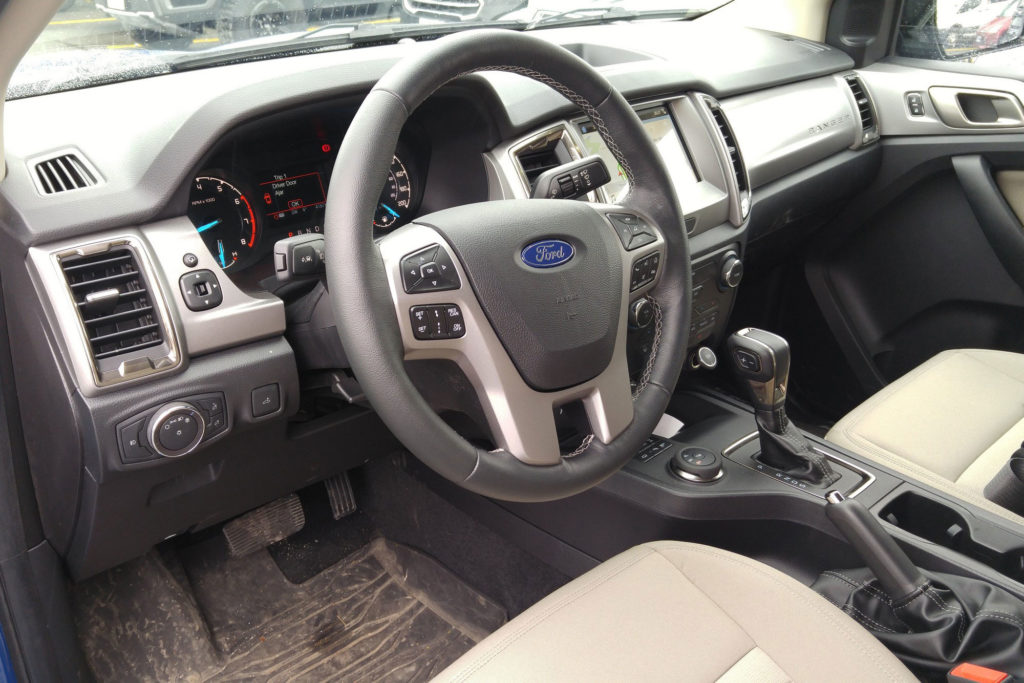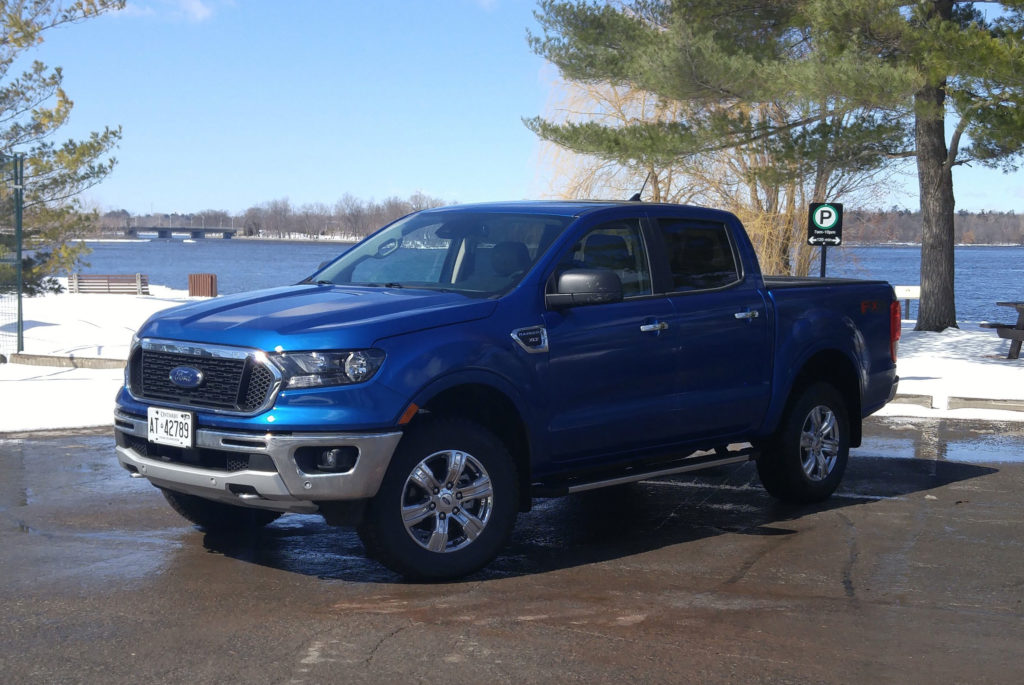The market for small pickups has undergone a big shift in the last few years. The changes began in 2015 with the Chevrolet Colorado and GMC Canyon, which returned from a hiatus as mid-size models to replace their compact predecessors. Toyota followed in 2016 with a redesigned Tacoma that had also grown larger.

Now it’s Ford’s turn, with a reborn Ranger, a name that disappeared from the pickup segment in 2012. What was last sold as a basic compact is back as a mid-size promising more refinement, performance and capability.
Turbocharged engine
Ford’s single engine offering is a 2.3L turbocharged four-cylinder that makes 270 hp and 310 lb-ft of torque. At higher engine speeds, it can’t quite match the performance of GM’s and Toyota’s optional V6s, but all that torque does make the Ranger feel potent when accelerating from a stop.

GM offers more variety in its Colorado and Canyon trucks, with four-cylinder gas and diesel engines and a gas V6. However, Ford has combined the best traits of diesel and gas engines in the Ranger’s sole powerplant.
10-speed automatic transmission
The Ford Ranger’s 10-speed automatic transmission is the first of its kind in a mid-size truck.

I know the pickup market is all about numbers, but the closely spaced ratios seem like overkill considering the engine’s torque. It’s a good thing the transmission works smoothly, because it seems like it’s always shifting.
Even at cruising speed, it responds to the smallest changes in road speed or gas-pedal movement. On a run between Ottawa and Toronto along Highway 7, the truck seemed happy to quietly cruise in 10th at about 90 km/h. However, even the slightest hill or gentlest acceleration would prompt a downshift to ninth or even eighth.
My test truck averaged 10.0 L/100 km in highway driving. Ford’s fuel consumption estimates are 11.8/9.8 L/100 km (city/highway).
Ride comfort
The Ranger’s ride is rough even by truck standards. There’s a lot of bounce over uneven pavement, especially from the rear, where the suspension is built more for payload capacity than comfort. Still, with an empty bed, the Ranger’s suspension felt less compliant than that of GM’s Chevrolet Colorado and GMC Canyon and the Toyota Tacoma.

Washboard surfaces brought out the worst of the ride in our test truck. Even after slowing down considerably for one particularly bad stretch of unpaved road, the rear end shimmied side-to-side alarmingly.

My Ranger test truck had an optional FX4 off-road suspension with specially tuned shock absorbers. If you don’t plan to do much off-roading, test-drive a Ranger with the standard suspension to see if you like the ride better.
Interior space, comfort and utility
Ford offers the Ranger in a SuperCab configuration with a long cargo box or a SuperCrew setup with a short box. My tester was a SuperCrew version, which gets full-size rear doors and seating.
- Front-seat headroom is good, but the cabin felt narrower than in the Chevrolet Colorado and GMC Canyon twins. The rear bench is family-friendly with useful legroom, but I’d be hesitant to squeeze three back there for longer journeys. In the SuperCrew, the rear cushions flip up to reveal under-seat storage.
- I appreciated the hand-operated parking brake in the console, which I prefer to the foot-operated pedal found in the Colorado and Canyon pickups.
- I had a couple of nitpicks with the Ranger’s secondary controls. One is that the steering wheel-mounted audio controls are awkward to use without moving your right hand away from the 3 o’clock position. Another is the air-conditioning temperature buttons, whose markings are hard to pick out at a glance.

Towing and payload
Ford says the Ranger is rated to tow as much as 3,401 kg with an optional hitch receiver upgrade and wiring harness. Payload is 748 kg in the SuperCab and 707 kg in SuperCrew form.
None of those figures are a lot lower than entry-level versions of Ford’s larger F-150 pickup.
Pricing and options

The 2019 Ford Ranger’s base price is $28,569 for a SuperCab model in XL trim. My SuperCrew test truck starts out in XLT trim at $34,939.
At that price, standard features include manual air conditioning, fog lights, forward collision warning with automatic braking, blind-spot monitoring, rear cross-traffic alert, automatic high beams and front and rear parking proximity sensors.
My Ranger’s options included a $1,500 package of the Sync 3 infotainment system, power-folding side mirrors, satellite radio and leather-trimmed steering wheel and shifter. There was also a $3,500 bundle of heated and power-adjustable front seats, a sliding rear window, remote engine start and a sport appearance package. The $1,400 FX4 off-road package adds grippier tires, special shock absorbers, locking rear differential and underbody skid plates. An $850 tech package groups navigation and adaptive cruise control, and the towing package that enables the Ranger’s 3,400-kg limit is $600.
All of those extras took my Ranger’s as-tested price to almost $43,000.
Conclusion
- One argument against mid-size trucks like the Ranger is that there’s too much price overlap with full-size models. But there are other arguments that favour a mid-size: their smaller stature makes them easier daily drivers, and their lighter weight means better fuel economy.
- The Ranger’s real advantage is Ford’s turbo engine. It makes a great impression, with a more powerful feel than any of this truck’s competitors. We wish we could have it along with the roomier-feeling cabin and smoother ride of the Chevrolet Colorado and GMC Canyon.
- Whether you feel the 2019 Ford Ranger was worth waiting for depends on the pickup truck qualities you value most — and where your brand loyalties lie. Even if you’re not a Ford person, the Ranger’s engine alone might be enough to make you switch teams.
2019 Ford Ranger
- Vehicle category: Mid-size pickup truck
- Engine: 2.3L four-cylinder, turbocharged; 270 hp, 310 lb-ft torque
- Transmission: 10-speed automatic
- Notable standard features (SuperCrew XLT; MSRP: $34,939): Manual air conditioning, fog lights, forward collision warning with automatic braking, blind-spot monitoring, rear cross-traffic alert, automatic high beams and front and rear parking proximity sensors.
- Notable options (As tested; MSRP: $43,000): Sync 3 infotainment system, power-folding side mirrors, satellite radio, leather-trimmed steering wheel and shifter, heated and power-adjustable front seats, sliding rear window, remote engine start, sport appearance package, navigation and adaptive cruise control.
- Fuel economy, ratings (l/100km, city/highway): 12.6/9.2


